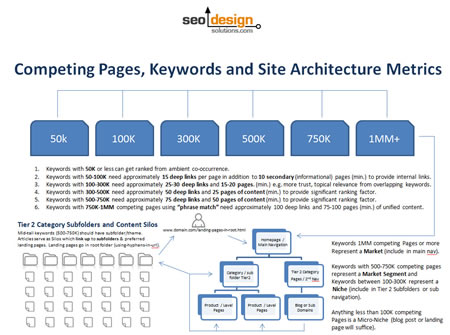Finding the proper SEO ratios for content, links and competing pages is critical for determining where each keyword fits in the hierarchy. This correlation between site architecture, URL, title, internal links and deep links determines which keywords are liberated from lackluster status to blockbuster SEO rankings.

Competing Pages SEO Deep Link / Internal Link Ratio
Within each page is a balance, this balance is between the aggregate layers represented by that page and what it can pass along through its own relevance score and whether or not that page is contributing to or detracting from the websites relevancy for the most competitive keywords the site is set on acquiring.
Under this assumption, a page is either passive or active within a site. This status depends on how the page is linked, the context of the keywords used on the page and / or linked to the page and how that page links to other pages within the site.
One thing to keep in mind is that depending on the number of pages within a website, an accommodating SEO strategy should coincide that takes the content deliverables into consideration and whether or not the main push will come from on page (internal links, content, navigation) or off page (links from social bookmarking sites, themed authoritative sites, blogs, directories, article marketing or widgets).
Using this as a vector to see the entire site as a vibrant ecosystem, each page represents a unique node of relevance (like a piece of a puzzle) that corresponds to a keyword or group of related keywords known as a cluster.
Regardless of which on page or off page metrics you employ, you will need to align the site architecture with those metrics based on how competitive the keyword is and where it fits into that parent theme or keyword cluster.
We use competing pages as a baseline in tandem with (1) how many pages are indexed (2) how old the site is (3) if relevant deep links are present (4) if the competitive keywords (over 1 million competing pages in phrase match) are in the primary navigation, secondary navigation, footer links, alt attributes, meta data or internal links.
However, for the sake of being concise, we are going to address the competing pages metric as a primary metric for elaboration.
Although each circumstance is different and each website unique; you can at least use this as a temporal benchmark for performance as an internal guideline for structure.
- Keywords with 50K or less can get ranked from ambient co-occurrence.
- Keywords with 50-100K need approximately 15 deep links per page in addition to 10 secondary (informational) pages (min.) to provide internal links.
- Keywords with 100-300K need approximately 25-30 deep links and 15-20 pages. (min.) e.g. more trust, topical relevance from overlapping keywords.
- Keywords with 300-500K need approximately 50 deep links and 25 pages of content (min.) to provide significant ranking factor.
- Keywords with 500-750K need approximately 75 deep links and 50 pages of content (min.) to provide significant ranking factor.
- Keywords with 750K-1MM competing pages using “phrase match” need approximately 100 deep links and 75-100 pages (min.) of unified content.
- Keywords with 2MM competing pages or more “using phrase match” need approximately 250 deep links and 200+ pages (internally linked) with a preferred landing page to gain expression.
Obviously there are variables for every aspect of SEO and how individual campaigns play out, however these assumptions are based on our tests using a new site starting fresh with no SERP history for a given keyword within the range of phrase match mentioned.
To find the threshold for competitive keywords, simply place the keyword or phrase “in quotes” and commence with a Google search. The number of results returned from the search indicates how many pages Google is currently using as a benchmark for indexed pages that include that keyword or key phrase variation.
For keywords under 200K competing pages, simple internal linking is often sufficient from consolidating the number of pages internally through virtual theming (linking to the preferred page from every keyword occurrence on other pages).
However for more competitive keywords the number of deep links from related or authoritative sites with the preferred anchor text is required to offset the barrier to entry. This is why we suggest for keywords between 300-500,000 competing pages that you employ a variety of deep links to aid the process and create a buoyant search engine rankings.
There is a fleeting metric to this equation which is domain and page authority, both will impact the SERPs and individual keywords based on their relative values. For example, as a site becomes more authoritative, the need for off page ranking factor diminishes. Also, the correlation between indexation and PageRank all flow through the connectivity of the site architecture.
This means that by tactfully integrating the more competitive keywords into common areas (block segments, server side includes, secondary navigation, footer links, alt attributes, etc.) you provide additional weight to the relevance thresholds required to produce a shift in ranking algorithms (to imply that THE TARGET PAGE is important).
You may find that based on the authority of the site that keyword objectives are acquired faster or slower, depending on the aggregate number of pages provide on a topic within the website. Yet, this document can at least establish a baseline for you to use to structure a worthy assault to offset competitors in their varying degrees of occupancy in the SERPs (search engine result pages) for the desired keywords.
The grandfather effect and brand rank are real (meaning that geriocracy is real as well as preferential treatment of domains), so, there are some instances where this metric is completely obsolete, in which case you would have to look at the number of EDU links, powerhouse sites linking to a page and / or domain as well as the relevancy of the theme, total number of pages dedicated to the keyword with the site (as a valid competitive metric).








This is a really helpful post, thanks Jeffrey. Can I ask whether the numbers you’ve provided above in regards to competing pages in phrase match are similar even if the target page is my homepage? It always seems harder to rank an inner page for a relatively competitive term than the homepage.
Also, does there come a point when there are too many pages in a site in relation to the number of links? For example, if I have 500 links to a site of 20 pages, if I then add another 100 pages without building more links does it dilute the strength of each page?
Thanks for any advice. Great post once again.
Justin
Hi Justin:
Phrase match was the metric “in quotes” to assess the competitive threshold for generalizing the barrier to entry. Domain authority and trust are the missing wild card ingredient that remain elusive for the most part. These numbers are based on our internal assumptions, although I can assure you they are effective metrics. Also, on your last question regarding link density for deep links and how concentrated the links are to a smaller group of pages vs. adding more content…
Ideally you want to have as many pages working together as needed to topple a competitive keyword. If you want to build more relevance, adding additional pages allows you to add more variations of flavor for modifiers, synonyms or suffixes to create link diversity. Also, the more pages indexed with additional deep links means the more ranking credit your domain houses. If each of those pages is optimized for 10 keywords wouldn’t you rather have 100 additional pages all ranking for ALL potential variations of a keyword or phrase that is lucrative?
Thanks for the explanation Jeffrey. I guess one of my site’s needs more link building. I’ve been adding many new pages recently but I don’t think they’re all remaining indexed. I’ll work on promoting each one and hopefully it’ll bring a traffic and ranking boost to all pages.
I’ll be printing your barrier to entry findings out! That will certainly come in handy for each site I build.
Thanks once again.
Keep me posted Justin:
We like the idea of gathering additional conclusive data…
Take Care
Hello.
Beginner to SEO here, and I’m constructing a site with developing silo architecture (just started).
My question is would a relevant and quality-filled OFFSITE silo of content that provides dofollow links to an ONSITE landing page also be a valuable thing to add or would all such silo-based content be more powerful if it were on the same URL as the landing page.
I ask because I as a beginner I have no real low-cost way to start developing dofollow backlinks. I figure if I make a quality Blogger or WordPress site (not a link scheme or spam) with relative silos that I will have some link juice from OFFsite backlinks. Of which I have none.
TY,
Tod
You can use that strategy (using a second ring site to push ranking factor back to the first ring). In fact, this is a deliberate method (link wheels) using aged, trusted sites, blogger, wordpress, etc. and getting links to those (since they have more chance of budding page rank and passing back trust and citation to your primary “money site”.
Just keep in mind that the more robust your silo for the first ring site, the less citation you will need from the 2nd or 3rd ring sites to provide off page ranking factor.